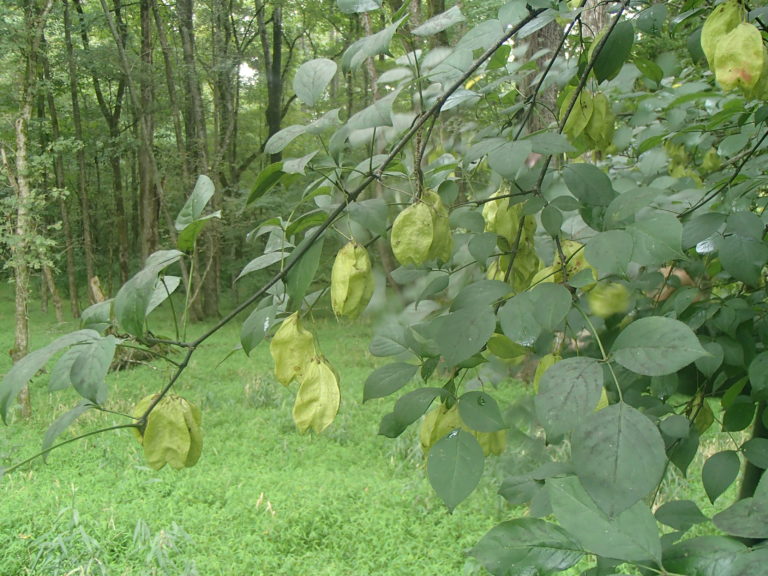American Bladdernut is an interesting understory shrub or small tree found in sometimes large colonies in Piedmont bottomlands and woodland thickets from the eastern mountains and piedmont into the midwest as far as Kansas and Oklahoma. It is not difficult to identify: Bladdernut typically grows 10-15′ tall, with opposite, trifoliate leaves, attractively furrowed bark, and drooping clusters of white, bell-shaped flowers in spring. These flowers give way to inflated, bladder-like, egg-shaped, papery seed capsules 1-2 inches long which mature in late summer and persist into early winter. Sometimes, this shrub is cultivated because of its attractive flowers and the ornamental seed capsules — which give rise to its common name — as well as its tolerance of shade. It grows in a wide range of soils as long as they are moist, and it grows best in partial shade in the understory of large deciduous trees.
NURSERY HOURS
Wednesday: 10-4 Thursday: 10-6 Friday-Saturday: 10-4 Sunday: 12-4
Staphylea trifolia

Key Info
Scientific Name: Staphylea trifolia L.
Common Names: American Bladdernut
Family Names: Staphyleaceae
Plant Type: Tree / Shrub
Leaf Retention: Deciduous
Flower Color: White
Special Characteristics: Seed capsules good in dried arrangements, Tolerates shade, Tolerates dry conditions, Tolerates Black Walnut
Additional Info
Habit: An understory shrub/tree, with young green-brown bark which develops nicely contrasting whitish fissures over time, the green-brown maturing to brownish-gray. The root system can form clonal offsets from underground runners. Occasionally, colonies of shrubs are formed.The woody root system has a main taproot with branching laterals.
Height: 8 to 15'
Spread: 8' to 20'
Soil Conditions: Medium to moist, well drained, fertile, loamy soil with abundant organic matter, acid, circumneutral, alkaline, sandy, loamy, clay soil even shallow, rocky soil.
Leaves: The opposite leaves are trifoliate. Individual leaflets are up to 2½ inches long and 1 inch across,ovate in shape and finely serrated along their margins. Each leaflet has a rounded to wedge-shaped base and tapers to a sharp tip. The upper surface is medium to dark green and hairless, while the lower surface is light green and pubescent. The terminal leaflet has a stalk up to 1 inch long, while the 2 lateral leaflets are nearly sessile.
Flowers (or reproductive structures: In spring, drooping clusters of stalked flowers appear in upper leaf axils before or as leaves emerge. Each flower is about 1/3 inch long, 1/4 inch across, and bell-shaped; it has 5 outer sepals which are green at first, turning white; 5 inner petals; several stamens, and a pistil. The slender pedicels are a little longer than the flowers. The blooming period lasts about 2-3 weeks.
Fruit: Flowers give way to inflated, 3-chambered, bladder-like, egg-shaped, papery seed capsules which mature from green in spring to yellow, to brown in late summer/fall, often persisting into winter. The seed capsules are up to 3 inches long and 2 inches across, ovoid in shape with 3-angular lobes. Most cells contain a single, 3-sided seed, brown, smooth, and about ¼ inch across, which will rattle around inside the capsule. These can be used with effect in dried flower arrangements.
Natural Distribution: Bottomlands, woodland thickets and moist soils along streams, moist floodplain woodlands.
USDA Hardiness Zone: 4 to 9
USDA Wetland Indicator Status in NC: FAC
Pollination: The flowers are self-incompatible and require cross-pollination by pollinators. Attractive to bees and wasps.
Wildlife Connections: The flowers attract many kinds of bees and flies which suck nectar from the flowers and feed on the pollen, as well as a few other species (Illinoiswildflower.info) Provides habitat for birds. This shrub is not a favorite of deer.
Propagation: Softwood cuttings, hardwood cuttings; seed (very slow).
